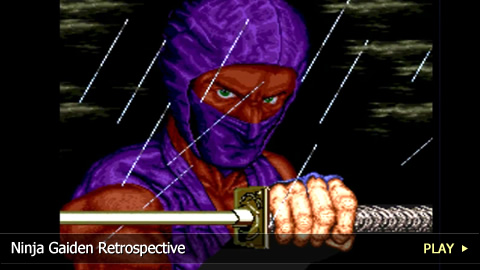Ninja Gaiden Retrospective

This modern day super ninja takes on the most challenging missions, leaving nothing but dismembered limbs in his wake. Welcome to WatchMojo.com and today we’ll be taking a look back at Ninja Gaiden Franchise.
This iconic first-person series, originally known as “Legend of the Ninja Dragon Sword” in Japan, made its North American arcade debut in 1988. Developed by Tecmo, “Ninja Gaiden”, literally translated as “Ninja Side-story”, was once a simple Double-Dragon inspired beat ‘em up.
In its first installment, players were introduced to Ryu Hayabusa, a blue-clad ninja on a quest across America to defeat an evil cult. Fighting with his bare hands, Ryu was able to perform back flips and flying neck throws. He was even able to gain power-ups, like the use of a sword, by breaking background objects.
Taking place in five different environments, the arcade game similarly featured only five types of enemies. Despite its limited variety, the romp left its mark on gamers with its intense difficulty, and infamous continue screen that featured a tied up Ryu being tortured with a circular saw.
The next year, the ninja returned to kick start his NES trilogy. The first game, simply titled “Ninja Gaiden” had the super ninja find a letter from his father who had gone missing. Asked to journey to America to meet an archeologist, he soon discovered that a cult had begun seeking out two hidden statues. These had the power to revive an ancient demon and end the world.
It was this console-based entry that first introduced many of the series’ iconic staples. These included its tight action-platform gameplay, boomerang-like Shuriken, use of magical ninja arts, catchy music and cinematic cutscenes.
An instant hit, Ryu returned the next year in “Ninja Gaiden II: The Dark Sword of Chaos.” Here, he had to stop the Emperor of Chaos, who had captured a CIA agent and taken control of a powerful blade, forged from the bone of a demon.
The trilogy quickly concluded with 1991’s “Ninja Gaiden III: The Ancient Ship of Doom.” The most difficult of the series, players found themselves much weaker than in earlier games. They were also forced to follow a convoluted story centered on a warship, a race of energy-infused superhuman mutants, an inter-dimensional rift, genetic engineering and secret rogue agents.
In 1995, the trilogy was re-released for the SNES in one game cartridge, and included such improvements as the use of passwords and better cinematics, as well as retouched graphics and soundtrack. The third game was also given a much more reasonable difficulty level.
Afterwards, the series received several ports for other systems, including Sega’s Genesis and Game Gear. It even received a Gameboy exclusive spinoff entitled “Ninja Gaiden Shadow”, which was set before the events of the other games and had players save New York from the forces of an emperor that served a demon.
Astonishingly, the franchise then lay dormant until 2004, when it was revived for the Xbox by developer Team Ninja. This game served as yet another prequel and had the hero don a new armored suit, use an all-new combat system and take on devilish puzzles. Here, the story was centered on the ninja surviving the decimation of his clan, and his quest to retrieve the Dark Dragon Blade while getting his revenge.
This soon spurred an upgraded edition called “Ninja Gaiden Black”, and a high def remake for the PS3, called “Ninja Gaiden Sigma.”
2008’s “Ninja Gaiden II” followed this adventure, which was a loose reimagining of the events of the second NES game. Incredibly well received, due in no small part to the generous amount dismemberment present in the early levels, it spurred the development of its own upgraded version called “Sigma II”, and a sequel for 2012. In an effort to show a more human side of Ryu, this latest installment will have Ryu remove his mask and decend into a hellish realm for more slice and dice.
An iconic gaming franchise that’s known for its nearly impossible difficulty, Ninja Gaiden continues to appeal to hardcore gamers with the kind of extreme violence that only a magical world-class ninja can dish out.
